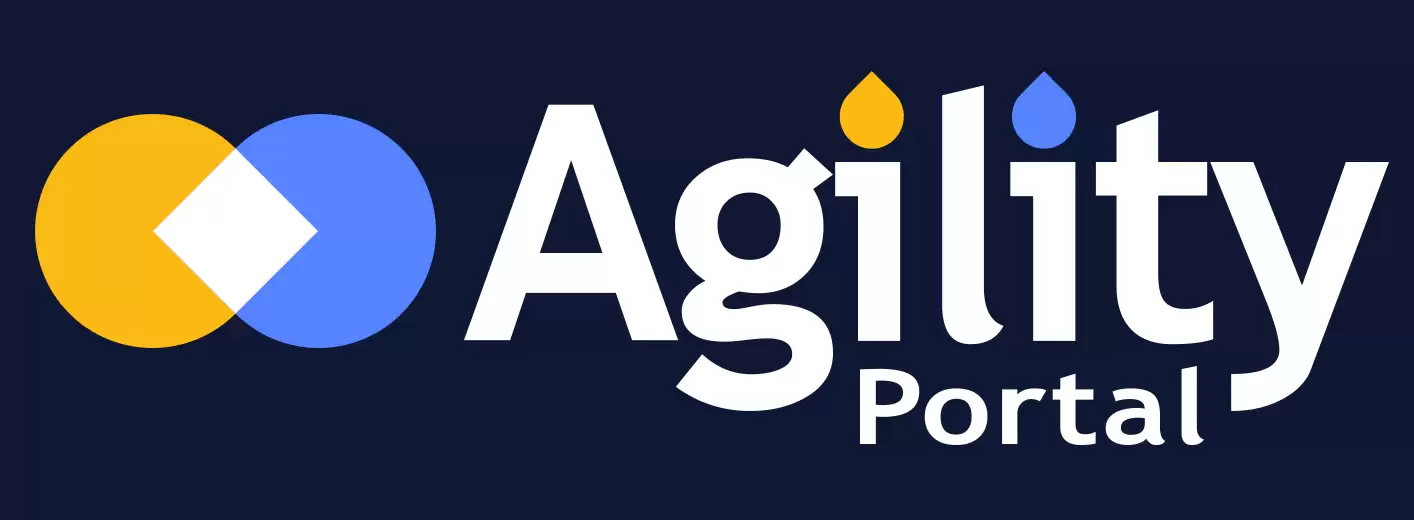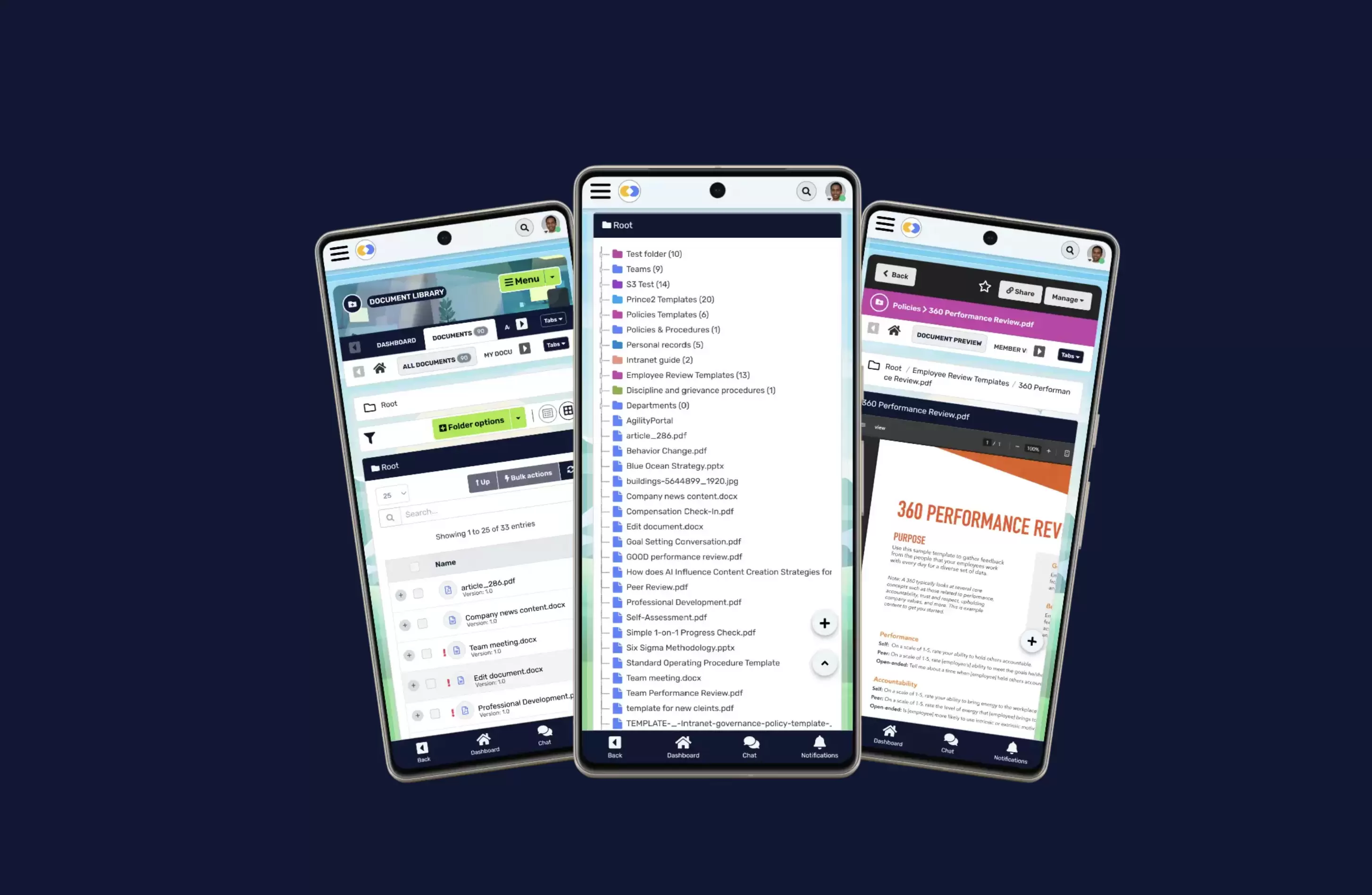Insight Blog
Agility’s perspectives on transforming the employee's experience throughout remote transformation using connected enterprise tools.
9 minutes reading time
(1848 words)
5 Ways a Digital Workplace Platform Can Help You Free Up Hours for Your Most Important Tasks
Discover what a digital workplace is, why it matters, and how the right strategy with collaboration tools can boost productivity and employee experience.
What do most businesses do when productivity drops or sales figures start to decline?
They often hire more staff or double down on time-consuming tasks like endless meetings and follow-ups.
But what if there were a smarter way to boost ROI and efficiency—without burning out your team or wasting precious hours? That's exactly what a digital workplace platform like AgilityPortal makes possible.
According to a McKinsey study, employees spend 28% of their workweek managing emails and another 20% searching for information or tracking down colleagues—that's nearly half the week gone before any real, high-value work gets done.
With the right tools in place, businesses can streamline communication, centralize documents, and automate repetitive tasks, freeing up hours for the work that actually drives growth.
Think of it this way: just like students look for faster solutions such as write my essay online for cheap to save time, businesses too can benefit from smart automation and collaboration tools to get more done in less time.
in this article we explain 5 Ways a Digital Workplace Platform Like Can Help You Free Up Hours for Your Most Important Tasks, starting with what are Digital Workplace Tools?
Read this article: : Top 6 AI-Powered Project Management Tools To Use In 2023
What Are Digital Workplace Tools?
Digital workplace tools are the backbone of today's modern organizations.
At their core, these are software applications and technologies designed to boost productivity, collaboration, and internal communication in a digital environment.
Unlike traditional office tools, digital workplace platforms bring everything together—messaging, project management, file sharing, knowledge management, and task automation—into one unified hub.
In a world where 74% of U.S. companies are adopting or planning to shift permanently to hybrid work models (Gallup, 2024), having the right tools isn't just "nice to have"—it's essential for keeping teams connected, engaged, and efficient.
By enabling real-time collaboration across time zones, secure document sharing, and workflow automation, digital workplace solutions empower businesses to work smarter, not harder.
Some common examples of digital workplace tools for remote teams include:
- Project management software to assign tasks, track progress, and hit deadlines
- Team collaboration platforms for instant messaging and video conferencing
- Cloud storage and file-sharing systems for easy access to documents
- Knowledge management intranets to store policies, training, and FAQs
- Employee engagement apps that encourage feedback, recognition, and participation
These tools don't just improve efficiency; they also support flexible work arrangements, foster stronger internal communication in hybrid workplaces, and create a digital culture where people feel connected—no matter where they are working from.
In the next section, we'll dive deeper into the 5 ways DWT can your reduce your time for your business needs in 2025 and show you how they can help streamline processes, reduce wasted time, and unlock new levels of productivity.
#1. Reduce Time Spent on Administrative Tasks
One of the biggest challenges sales teams face is the overwhelming amount of administrative work that eats into their day.
From scheduling meetings and following up on leads to managing email correspondence, sales professionals often spend more time on manual tasks than on actual selling. In fact, research shows that salespeople spend only 28% of their time selling, while the rest is consumed by admin duties and meetings.
The good news? Modern sales productivity tools and digital workplace platforms can automate much of this workload, giving sales teams more hours to focus on building relationships and closing deals.
Take meeting scheduling as an example. Instead of endless email back-and-forth, meeting booking software for sales teams allows prospects to book a time directly in the salesperson's calendar.
The system syncs with popular apps like Google Calendar and Office 365 Calendar, ensuring real-time availability without double bookings.
Better yet, when a new lead books a meeting, the tool automatically creates a new contact in the CRM system, eliminating manual data entry. Sales reps can also set rules for buffer times, breaks, or preparation windows, ensuring they're never overwhelmed with back-to-back calls.
By reducing these repetitive administrative tasks, companies can boost sales efficiency, improve lead management, and create a more seamless experience for both teams and clients.
#2. Streamline Internal Communication Across Teams
Poor communication is one of the biggest time-killers in any organization.
When messages are scattered across emails, chats, and endless meetings, employees spend more time searching for answers than actually working.
A study by McKinsey found that improved communication and collaboration can boost employee productivity by up to 25%, making it one of the fastest ways to free up valuable hours.
A digital workplace platform like AgilityPortal provides the structure and tools to make this happen. Instead of switching between apps, your team can communicate in real time through team collaboration software for remote teams, share updates instantly, and keep all conversations in one searchable hub. This eliminates information silos and reduces the frustration of missed emails or duplicated work.
For businesses operating in flexible or hybrid setups, internal communication in hybrid workplaces becomes even more critical.
Employees need quick access to project updates, feedback, and company announcements—whether they're working from the office, home, or on the go.
AgilityPortal's digital workplace communication tools ensure that everyone stays in the loop with notifications, chat channels, and discussion boards tailored to teams and departments.
The result? Clearer, faster communication that reduces misunderstandings, shortens decision-making cycles, and gives your employees back the time they would have wasted chasing down information.
#3. Centralize File Sharing and Knowledge Management
One of the most common reasons employees lose valuable time is the simple act of searching for documents.
According to IDC, the average worker spends 2.5 hours a day just looking for information—that's more than a full working day every week lost to disorganized files.
A digital workplace platform like AgilityPortal eliminates this problem by acting as a knowledge management intranet where everything your team needs is stored, organized, and searchable in one place.
Instead of digging through email threads or juggling multiple file-sharing apps, employees have instant access to policies, training materials, project files, and templates whenever they need them.
With centralized document storage, businesses can ensure that everyone is working from the most up-to-date version of a file, reducing costly errors and duplicate work. Permissions and access levels also make it easy to keep sensitive information secure while still empowering teams with the resources they need to succeed.
For remote and hybrid organizations, the ability to share and collaborate on files in real time is a game-changer.
File sharing tools for remote teams within AgilityPortal allow employees to upload, review, and co-edit documents without switching between different apps. This not only cuts down on wasted time but also creates a single source of truth for your organization's knowledge base.
The result is simple: less time wasted searching for information and more time focused on strategic, high-value work that drives results.
#4. Enhance Project Management and Task Tracking
Managing projects across multiple teams can quickly become chaotic without the right system in place. Missed deadlines, unclear responsibilities, and scattered updates are some of the biggest productivity drains for businesses.
In fact, PMI research shows that organizations lose 11.4% of investment due to poor project performance, largely caused by inefficient tracking and communication.
This is where a digital workplace platform like AgilityPortal makes a real difference.
By combining project management software for hybrid teams with integrated communication tools, it ensures that every task, deadline, and responsibility is visible in one central hub. Managers can assign tasks, set priorities, and track progress in real time, while employees gain clarity on what needs to be done and when.
With built-in task management tools for businesses, teams can break down large projects into manageable steps, automate reminders, and ensure accountability without relying on endless email chains. This creates a culture of transparency where everyone—from leadership to frontline staff—has visibility into project status and bottlenecks.
For hybrid and remote organizations, digital workplace project tracking is especially valuable.
Whether your team is spread across time zones or departments, AgilityPortal provides dashboards and reporting tools that keep everyone aligned. Instead of wasting hours chasing updates or reconciling spreadsheets, businesses can focus on delivering projects faster, with fewer errors, and with measurable results.
The outcome?
Projects move smoothly, deadlines are met, and employees spend less time on coordination and more time on impactful work.
#5. Simplify Employee Onboarding and Training
Bringing new employees up to speed is often a time-consuming process.
HR teams and managers spend hours explaining policies, sharing documents, and answering the same questions again and again. According to Glassdoor, organizations with a strong onboarding process improve new hire retention by 82% and productivity by 70%—but without the right tools, onboarding can quickly overwhelm both employees and managers.
A digital workplace platform like AgilityPortal simplifies this by centralizing all onboarding resources in one easy-to-access hub. New hires can find training videos, company policies, and step-by-step guides without needing to constantly ask for help. Features like knowledge hubs, self-service portals, and digital checklists for onboarding mean employees can learn at their own pace while still having structured support.
For managers, this reduces repetitive administrative work and frees them to focus on mentoring rather than paperwork. For employees, it creates a smoother transition, building confidence and engagement from day one.
By using a digital onboarding and training solution, businesses not only reduce workload for HR and team leads but also ensure consistency across departments, making sure every new employee receives the same quality experience.
The result?
Faster onboarding, less repetitive training for managers, and employees who feel more empowered and productive right from the start.
Read this article: : Top 6 AI-Powered Project Management Tools To Use In 2023
Defining the Digital Workplace
Although the digital workplace is now shaping projects across nearly every industry, the concept itself is still evolving.
Different organizations and experts define it in different ways—some take a broad, all-encompassing approach, while others focus on very specific aspects like communication or collaboration.
At its core, the digital workplace is the natural evolution of the traditional workplace.
It represents all the technologies employees use to get work done—everything from HR applications and project management tools to email, instant messaging, intranets, and enterprise collaboration platforms. In reality, almost every business today already has some form of a digital workplace, even if they don't formally call it one.
The key isn't just having digital tools—it's about creating a connected, coherent, and employee-friendly environment where these tools work together seamlessly.
A well-structured digital workplace should remove friction, streamline communication, and make it easier for staff to perform their jobs effectively and efficiently. When designed properly, it enhances both the employee experience and the organization's overall productivity.
Your business communication platforms should form an integral part of this strategy.
By aligning messaging apps, enterprise collaboration tools, and knowledge management systems under one digital workplace framework, you create workflows that are not only more efficient but also more engaging for employees.
In short, the digital workplace isn't just about technology—it's about building a smarter, more connected environment where people can thrive and businesses can grow.
Categories
Blog
(2571)
Business Management
(314)
Employee Engagement
(204)
Digital Transformation
(171)
Intranets
(119)
Growth
(115)
Remote Work
(61)
Sales
(48)
Collaboration
(37)
Culture
(29)
Project management
(29)
Customer Experience
(25)
Knowledge Management
(21)
Leadership
(20)
Comparisons
(5)
Ready to learn more? 👍
One platform to optimize, manage and track all of your teams. Your new digital workplace is a click away. 🚀
Free for 14 days, no credit card required.













